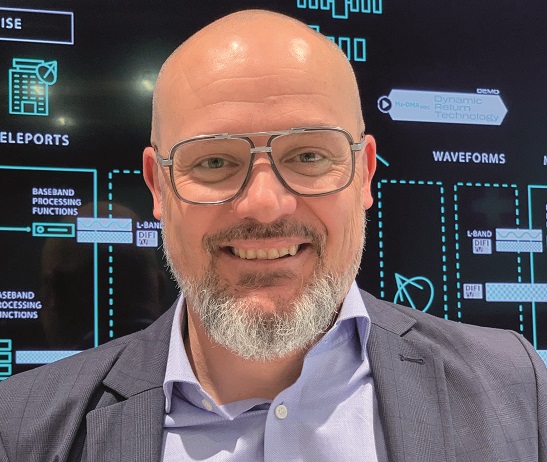 As new software technologies begin to deliver higher bandwidth, faster speeds, and more reliable services, attention is focusing on changes in the ground segment. Virtualised ground operations are now being seen as the missing link in a fast-advancing industry shaped by innovations such as software-defined satellites, multi-orbit constellations, and 5G-enabled terrestrial networks.
As new software technologies begin to deliver higher bandwidth, faster speeds, and more reliable services, attention is focusing on changes in the ground segment. Virtualised ground operations are now being seen as the missing link in a fast-advancing industry shaped by innovations such as software-defined satellites, multi-orbit constellations, and 5G-enabled terrestrial networks.
Conventional ground systems often slow down communications between satellite and terrestrial networks with their rigid and manually operated design. But virtual ground systems could eliminate these constraints while supporting new use cases, thanks to their potential to centralise operations, reduce complexity and improve overall business efficiency.
Simply put, virtualisation is a game changer for the ground segment. It allows software to abstract away the underlying hardware, making it more flexible and adaptable to different uses. Not too soon for an industry undergoing the most significant transformation of its five-decade lifespan.
Ahead of Satellite 2023 in Washington D.C. this year, Kratos Defense & Security Solutions announced OpenSpace vStar, its first virtual replacement for the traditional hardware-based hubs used in satellite communications (satcom) today. The goal is to modernise satcom ground systems and support smooth interoperations with terrestrial and cellular networks, Greg Quiggle, SVP of Space Product Management at Kratos, told SatellitePro.
“With 5G, the wireless industry has shifted from purpose-built hardware equipment to flexible, software-defined networks, called vRANs, expanding their markets and services in the process. OpenSpace implements this same model to mainstream satcom services with the rest of the global communications infrastructure while simultaneously capitalising on the advanced capabilities built into the new generation of software-defined satellites,” he said.

Kratos calls vStar the new model for satcom networks. It digitally transforms the gateway, replacing traditional hardware hubs with software equivalents that can run on generic x86 computing platforms in the data centre or the cloud. It is no longer concentrated at one physical location and can be run almost anywhere.
Satellite operator Intelsat announced recently that it will employ OpenSpace vStar technology as part of the advanced network being built to deliver services for its new family of software-defined satellites.
By virtualising the functions of a traditional hub, satcom operators using vStar benefit from services at an enterprise-grade scale without the limits of hardware hubs. Few companies have achieved the level or scope of ground segment virtualisation Kratos has, Quiggle says.
The OpenSpace platform enables customers to configure the ground system to receive information from overhead satellites and command them for their next mission during their short visibility window. “We did this with success with several customers and today have more than 100 production networks deployed around the world with very large players, including the cloud players such as Amazon Web Services (AWS)and Microsoft,” he says.
“If you look at a ground system today, it’s mostly hardware. With OpenSpace, we’ve looked at each of the individual components within a gateway – modulators, demodulators, modems, channelisers, combiners – and replaced them with a containerised equivalent. These are now deployable within a private or public cloud, so that you can dynamically spin them up for a satcom service. And then when you’re done with that service, spin them back down, and the compute goes right back into the cloud,” he adds.
$6bn in baseband revenues

Revenues from these baseband components are growing at a compound annual rate of 12.9% as the ground segment virtualisation enables new market growth, according to the seventh edition of NSR’s Global Satellite Ground Segment report.
Over the decade to 2031, that growth could generate $6bn in cumulative revenues, says Lluc Palerm Serra, NSR Principal Analyst.
“Eventually, we see most of the elements of the ground segment system and even the space segment moving into virtual functions,” he told SatellitePro.
That could be as little as three to five years away, although several factors need to come together for the industry to realise true value from the transition. Such elements include technologies, standards and infrastructure strategies, as well as a broader definition of different roles for ecosystem players, such as hyperscalers.
Exceptional technology alone won’t be enough, he warns, and satcom vendors will need to identify the right business strategy to stay relevant, such as by becoming ‘network functions vendors’ with a capabilities-based model.
Network management systems (NMS) for ground management and control are the first step towards a virtual world, Palerm Serra says, with most ground systems vendors already offering these in some form.
“Then we can expect to see more utilisation of baseband equipment, so that what was traditionally a hub with line cards will move to the cloud – whether these functions are hosted in a public cloud such as Azure or AWS, or a private cloud. And eventually, you would see also that happening on the terminal side of things, but maybe that’s not that’s not so advantageous in terms of cost,” he says.
What’s driving virtualisation of the ground segment?
Customers are turning to virtualised ground systems to drive efficiencies across the ecosystem and unlock new value while also enabling scalability and automation. In the cellular industry, for example, cloud providers such as Azure and AWS have demonstrated how virtualisation supports more agile and scalable networks.

With more satellites than ever before, particularly in low-earth orbit (LEO), ground systems need to be more responsive and flexible, particularly to support dynamic constellations. Additionally, with growing demand for data services and higher throughput, the industry requires systems that can process and manage large volumes of data in real-time.
“We have seen a growing interest from our satellite operating customers in the MENA region for virtualised ground stations that can provide more flexibility, scalability, and cost efficiency,” says Wolfgang Berger, Director of Digital Products at WORK Microwave.
The company recently launched a Virtual Ground Station (VGS) solution, a cloud-native, software-defined ground station architecture that enables satellite operators to manage almost their entire ground infrastructure from a single web-based interface, with features such as dynamic bandwidth allocation, automated workflows, and real-time monitoring and analytics.
It supports subscription-based approaches such as ground-station-as-a-service (GSaaS) and software-as-a-service (SaaS), enabling operators to reduce upfront hardware investments.
“We believe virtualisation will continue to play a key role in the evolution of the satellite industry, as it can unlock new business models, applications, and revenue streams,” Berger says.
Similarly, virtualisation in other areas is driving changes on the ground and helping expand flexibility in the process.
As software-defined satellites become the norm, the ground segment needs to be intelligent to respond in line with customers’ needs, says Ramesh Ramaswamy, Executive Vice President and GM International at Hughes Network Systems.
“Satellites have become more flexible, so they can move capacity around. And the ground segment has had to adapt,” he tells SatellitePro. This evolution will see terminals becoming more powerful and cost-effective.

The Echostar subsidiary is the industry’s largest manufacturer of very small aperture terminals (VSATs). Hughes’ Jupiter ground system enables connectivity worldwide, including in Oman, India, Egypt and sub-Saharan Africa. The latest iteration of Jupiter technology incorporates software-defined satellite networking, dynamic in-route reconfiguration for improved efficiency, and a new ‘system on a chip’ in every user terminal that can support increasingly high speeds and a variety of services.
The ground system has inbuilt flexibility, Ramaswamy says. “Flexibility is always there. Where your default gateway fails, you move to another gateway. Or if it’s based on cloud architecture, you can route traffic between gateways based on congestion. Now, we’ve integrated that intelligence to work with software-defined satellites, to be able to allocate capacity in the satellite market.”
Ground virtualisation will further come to the fore with the growth of multi-orbit operations. Satcom is expanding from GEO satellites to non-geostationary orbit (NGSO) systems, primarily in medium-earth orbit (MEO) and LEO. Every orbit has its own distinct advantages, including reduced latency, improved performance, capability to provide mobile connectivity, higher data transfer rate, and lower cost per unit of data. In this context, operators are setting themselves apart by promising to provide customers with the best of all orbits.
“The ground segment enables satellite operators to manage their multi-orbit constellations as a single network, maintaining seamless, uninterrupted service for users while switching between orbits. This occurs while maximising the benefits of each constellation per application and per region configuration with varied service options and delivering orbit redundancy,” explains Gil Elizov, VP of Product at Gilat Satellite Networks.
“With virtualisation and service chaining, we can achieve efficient orchestration of ground segment resources so that functions are deployed and activated dynamically only when needed,” he adds. “Gilat’s SkyEdge IV single platform for multi-orbit operation enables deployment on GEO very high throughput satellites (VHTS) as well as MEO constellations including seamless handovers between orbits, implementing ‘make before break’ for an uninterrupted and transparent user experience.
Launched in 2022, the nextgen satcom system is aimed at capturing a significant position of the emerging multibillion-dollar VHTS market opportunity. The system offers scalable software centricity and provides VSAT backward compatibility with existing SkyEdge II-c investments.
Network management and the cloud
The biggest changes are taking place in network management systems (NMS). Because network functions can be decoupled from hardware, managing and upgrading the network becomes easier, resulting in reduced downtime and increased reliability. Moreover, greater automation, such as by way of resource allocation, fault management, and service provisioning, can further improve network efficiency and reduce operational costs.

Gilat’s Network Management System, for example, was designed to support virtualisation. It is a microservice-based cloud-native application featuring standard interfaces to next-generation satellite resource managers and service orchestrators.
Elsewhere, ST Engineering iDirect is among those leading the shift to a fully digitised and virtualised ground infrastructure to expand the accessibility of satellite services around the world via the cloud.
Satellites provide cloud-based enterprise networking to companies around the world; it makes sense for the industry to use those networks to its own advantage.
The company has already migrated its network management system to the cloud. Now it is developing a virtualised modem in the cloud in partnership with Microsoft. In September, it showed how a virtual modem can decode a high-speed satellite signal via a digital interface instead of the traditional analogue L-band interface.
Cloud deployment allows satellite service providers to build out large scale networks in less time and with less capex-investment, enabling faster, more cost-effective scale, the company says. ‘Cloudification’ allows for a distributed, more reliable architecture with access to greater security, proven management tools, streamlined operations, and less dependence on hardware supply chains.
The next step is to migrate our network processing functions and lastly baseband processing functions to the cloud.
“Our network processing is now totally virtual,” Bert van der Linden, Senior Principal Product Manager, ST Engineering iDirect tells SatellitePro.
He expects the company’s push towards cloudification to reward its customers. “In terms of scale, you’re going to go from mini to max,” he says. While he acknowledges there are questions around reliability, he says cloud resources make it easier to build a more reliable platform, in part because of redundancy and automated deployment.
Challenges thick on the ground ahead
But while virtualisation signals a paradigm shift towards digitalisation for an integral industry segment, it comes with several challenges.

First, as with most new technologies, cost remains a considerable hurdle. Justifying computing costs can be an issue, Gilat’s Elizov says. In traditional IT environments, the total cost of ownership prioritises capital expenditure (CAPEX) while cloud computing operates on a pay-as-you-go basis (OPEX).
The outlay in each case will depend on the size and scope of the operation.
Hughes’ Ramaswamy defines it in cloud terms: “The cost impact of a cloud-based deployment depends on network size, allowing customers to start small and scale as they grow. The initial investment to deploy a small cloud gateway would be lower than a dedicated one. For large networks, a hybrid private-public cloud approach would probably be more cost-effective.”
Security is often cited as a major issue in what is one of the world’s most critical industries.
Quiggle says that’s an incorrect perception. “A lot of people generally assume that virtual systems are software-based, so they are less secure. But if the software’s implemented properly, that couldn’t be further from the truth,” he says.
In a hardware-based system, fixed endpoints provide an easy, long-term target for adversaries. However, in a software-based or software-defined system, the endpoint changes regularly with dynamic network orchestration, making it more difficult for attackers to exploit vulnerabilities. This constant change of the attack vectors is a major advantage of virtualisation, he explains.
Work Microwave’s Berger agrees. He says the need for secure and resilient ground systems that can withstand cyber threats and natural disasters is driving the adoption of virtualisation. Cloud-based solutions can provide greater redundancy, disaster recovery, and security features than traditional ground systems.
That’s not to ignore the need for robust security features that also ensure regulatory compliance requirements. Berger lists measures such as encryption, firewalls, intrusion detection and prevention systems, and strict access controls as well as conducting regular security audits.
It’s critical that vendors identify common customer needs when designing virtual networks, Elizov adds.
“There are different types of technologies, different types of cloud, different ways to operate over the cloud, different orchestration frameworks, and more. It is important to productise a virtualised platform without having to customise it per customer,” he says. “To overcome this challenge, cloud service providers must determine and support the widest common denominators across the global customer base while at the same time developing infrastructure that can easily customise solutions where needed.”
Not only must different virtualised ground station solutions be compatible, but virtual ground systems must also be able to connect and transmit information with other elements, such as satellites themselves, satellite operations centres and user terminals.
Finding common ground for industry development
 On this front, several players have already begun to work with the Digital Intermediate Frequency Interoperability (DIFI) standard, developed by the independent DIFI space industry consortium. The standard enables digital transformation in the space industry by providing IF/RF layer interoperability, so manufacturers can build flexible technologies in response to changing customer demands.
On this front, several players have already begun to work with the Digital Intermediate Frequency Interoperability (DIFI) standard, developed by the independent DIFI space industry consortium. The standard enables digital transformation in the space industry by providing IF/RF layer interoperability, so manufacturers can build flexible technologies in response to changing customer demands.
“DIFI’s mission is to accelerate the digital transformation of the satellite industry,” DIFI Board Chairman Stuart Daughtridge said in March. “That work starts with developing and making widely available a simple, open, interoperable Digital IF/ RF standard that replaces the natural interoperability of analogue IF signals and helps prevent vendor lock-in.”
DIFI membership now includes nearly 60 companies and agencies including the US Navy, US Space Force, AWS, Microsoft, Kymeta, Kratos Defense & Space, Hughes Network Systems, Inmarsat and Comtech.
In March, Gilat and ST Engineering iDirect demonstrated interoperability between their technologies by converting analogue signals to digital using the DIFI standard over a 10 Gbps fibre connection. They showed how an iDirect modulator was able to output a digitised signal that is interoperable with a BUC from Gilat’s Wavestream subsidiary.
It is this sort of collaboration that will ultimately shape the uptake of virtualisation both in the ground segment and elsewhere and support the growth of the industry.
 The ground segment has so far been dominated by proprietary systems.
The ground segment has so far been dominated by proprietary systems.
Now, the industry needs more clarity around different aspects of the ecosystem, Palerm Serra says. Wide implementation of the DIFI standard could take several years and there remain ecosystem gaps that prevent full adoption of virtualisation.
“It’s still early stages in the definition of the value chain. It’s not just a matter of visualising the ground segment, but also about realising the satellite industry’s capabilities,” he says.














Add Comment